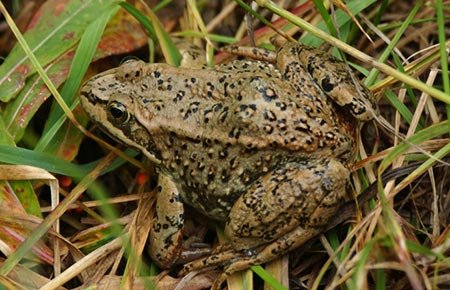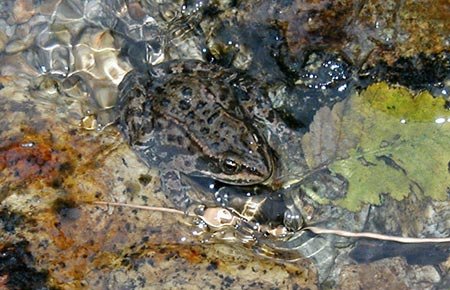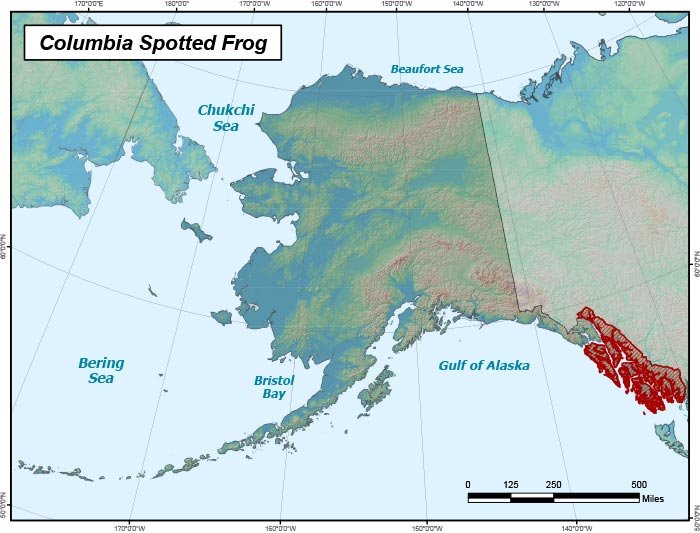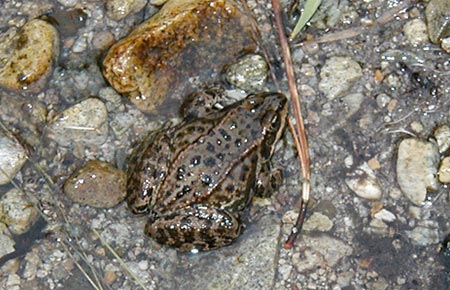In wildlife , fauna resources are important in the environment this is one of the animals
Columbia spotted frogs are bumpy-skinned, medium-sized frog with relatively short hind legs, inconspicuous dorsal folds, and fully webbed toes. Individuals vary from light to dark brown above with a scattering of large black spots often with light centers. Underside is creamy or mottled gray, with a covering of bright salmon or red on lower abdomen and undersurfaces of hind legs in adults. Light stripe on the upper jaw, and the eyes are upturned. Adults may grow to 7.6 cm. This species is larger than the wood frog (R. sylvatica), has bright salmon color over ventral surfaces, and lacks a dark eye mask or light vertebral stripe. Distinguished from the introduced red-legged frog (R. aurora) by its shorter legs (heel of hind leg when extended forward falling short of snout), with greater webbing, rougher skin, upturned rather than out-turned eyes, shorter jaw stripe, and lack of mottling on the groin.
Females are significantly larger than males, which has been correlated with increased fecundity. Males however, have significantly wider forearms than females, and studies have shown that this is due to increased reproductive success.
Life History
Growth and Reproduction
The Columbia spotted frog is an explosive breeder which exhibits a scramble competition mating system. These frogs breed in Southeast Alaska generally as early as winter thaw permits. Males attract mates by a series of calls to breeding sites at which the male arrives to early. The males prepare the oviposition site at which females lay their egg mass, which may contain up to 1,300 eggs. The Columbia spotted frog is the only known frog species having this characteristic. Oviposition sites are prepared in shallow water containing aquatic vegetation. The eggs hatch in 3–21 days depending on temperature. Metamorphosis occurs before fall or tadpoles may over-winter and metamorphose the following spring. They are sexually mature in 2–6 years, depending on location and elevation (matures later at high elevations).
Feeding Ecology
The Columbia spotted frog is an opportunistic feeder. It eats a wide variety of terrestrial and aquatic insects as well as different mollusks, crustaceans, and arachnids. Larvae eat algae, organic debris, plant tissue, and minute aquatic organisms.
Migration
Columbia spotted frogs may make short movements between breeding and non-breeding habitats. Males arrive in breeding areas prior to females. Although studies have reported a small number of individuals traveling up to 6.5 km from their breeding or over-wintering sites to summer foraging areas, most individuals traveled less than 1,000 meters to summer foraging areas. Gender differences have also been documented in which male frogs are shown to travel longer distances than females.

This is just to give us the blue print of what we are saying
Where can we get the species of this animal?
Range and Habitat
Columbia spotted frogs are present in coastal forests of Southeast Alaska, although range limits are not precisely known. Their present distribution is confined to coastal transboundary river corridors of continental mainland in Southeast, such as Salmon, Taku, Stikine and Unuk rivers and the Agassiz Peninsula. They have also been documented on Mitkof, Sergief and Vank Islands within the adjacent Alexander Archipelago, however, the Mitkof Island population (in and near the city of Wrangell) is possibly introduced. There have been reports of Columbia spotted frogs at one location along the Juneau road system, but it is suspected this was also an introduction. They have also been reported but not confirmed in Haines area.
The Columbia spotted frog is closely associated with permanent water and is rarely found far from it. They prefer bodies of water with little variation in size between seasons, and in seasonal water temperature, and areas with high vegetation. They are found predominantly in outwash ponds and backwater lakes, beaver ponds, muskeg ponds, river channels, and streams. They prefer shallow waters that are densely vegetated for oviposition sites. Oviposition sites with vegetation provide shelter and protection from predators, feeding sites, and warmer water.
habitat
Status, Trends, and Threats
Status
•NatureServe: G4
•IUCN: LC (Least Concern)
•ESA: Candidate
Trends
Current population size of the Columbia spotted frog is unknown. Population studies conducted at isolated ponds in the Taku, Stikine and Unuk River corridors estimated local populations ranged from 7 to 594 Columbia spotted frogs per pond and densities ranging from 0.07 to 1.49 spotted frogs per square meter of pond habitat.
Threats
Human-caused direct impacts are low due to protection throughout a large part of its range in the Tongass National Forest and Misty Fiords National Monument. Filling or draining of wetland habitat and alterations to ground or surface water flow from development are potential hazards. Chronic or acute water contamination from existing and proposed mining activities on the Canadian reaches of the Taku and Stikine Rivers may be of concern. Existing wetlands in the Taku and Stikine River corridors may be significantly reduced as postglacial rebound continues.
Studies done indicated that declines are suspected given the Columbia spotted frogs' susceptibility, the prevalence of fungus, and declines in other parts of Pacific Northwest. Populations associated with mainland river systems of Southeast Alaska have likely declined, but they still occupy their former range.

Range map
Fast Facts
•Size
Length: 7.6 cm
Range/Distribution
Coastal forests of Southeast Alaska
•Diet
Adults: Invertebrates
Larvae: Algae, organic debris, plant tissue, and minute aquatic organisms
•Predators
Predatory fish, raccoons, herons, river otters, garter snakes
•Reproduction
Explosive breeding occurs in spring, females lay egg masses which hatch in 3-21 days

I believed,you have gotten some knowledge on the post below are some other animals you may like to know about
*Beaver*
*Caribou*
Thanks for reading!!!
Source: Alaska Department of fish and game
Hi! I am a robot. I just upvoted you! I found similar content that readers might be interested in:
http://www.adfg.alaska.gov/index.cfm?adfg=columbiaspottedfrog.main
Good work robot!